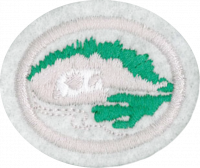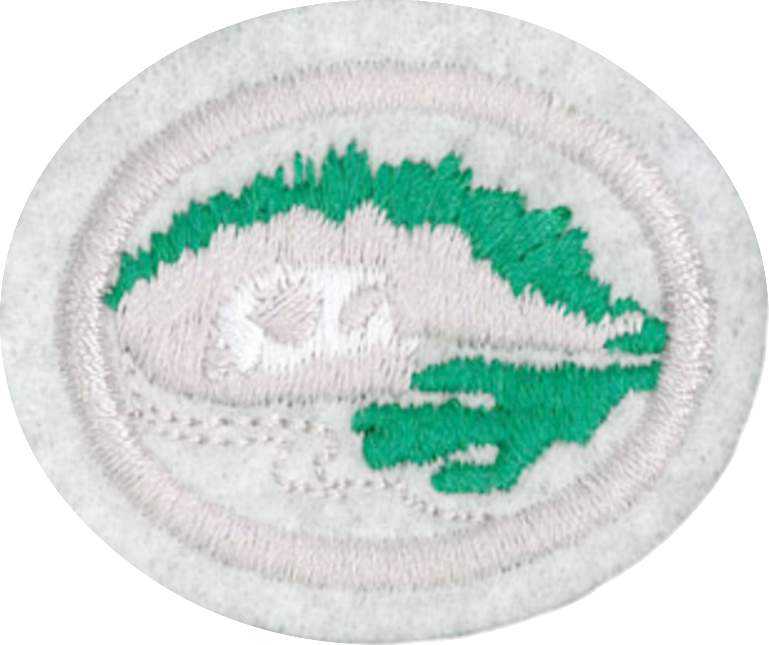|
|
| (24 intermediate revisions by 2 users not shown) |
| Line 1: |
Line 1: |
| − | <languages /><br />
| + | {{HonorSubpage}} |
| − | <noinclude></noinclude>
| + | <section begin="Body" /> |
| − | {{honor_desc/es | |
| − | |stage=00
| |
| − | |honorname=Líquenes, hepáticas y musgos
| |
| − | |skill=3
| |
| − | |year=1961
| |
| − | |category=Estudio de la naturaleza
| |
| − | |authority=Asociación General
| |
| − | |insignia=Lichens_Liverworts_and_Mosses_Honor.png
| |
| − | }} | |
| − | | |
| − | {{IAConnection/es|[[Investiture_Achievement/Ranger/Nature_Study/es|ORIENTADOR Estudio de la naturaleza]]|(como una de dos opciones) completar un proyecto que es igual al requisito #6 de esta especialidad|}}
| |
| − | | |
| − | <noinclude></noinclude>
| |
| − | <section begin="Body" /> | |
| | {{ansreq|page={{#titleparts:{{PAGENAME}}|2|1}}|num=1}} | | {{ansreq|page={{#titleparts:{{PAGENAME}}|2|1}}|num=1}} |
| | <noinclude></noinclude> | | <noinclude></noinclude> |
| − | <!-- 1. Know the life cycle of a moss, lichen, or liverwort. --> | + | <!-- 1. Conocer el ciclo de vida de un musgo, un liquen o una hepática. --> |
| − | ===Life cycle of moss===
| |
| − | Most kinds of plants have a double portion of chromosomes in their cells (diploid, i.e. each chromosome exists with a partner that contains the same genetic information) whilst mosses have only a single set of chromosomes (haploid, i.e. each chromosome exists in a unique copy within the cell). There are periods in the moss lifecycle when they do have a full, paired set of chromosomes but this is only during the sporophyte stage.
| |
| | | | |
| | {{clear}} | | {{clear}} |
| Line 27: |
Line 11: |
| | {{clear}} | | {{clear}} |
| | | | |
| − | In some mosses, green vegetative structures called gemmae are produced on leaves or branches, which can break off and form new plants without the need to go through the cycle of fertilization. This is a means of asexual reproduction.
| + | {{clear}} |
| | | | |
| | {{clear}} | | {{clear}} |
| Line 43: |
Line 27: |
| | {{ansreq|page={{#titleparts:{{PAGENAME}}|2|1}}|num=2}} | | {{ansreq|page={{#titleparts:{{PAGENAME}}|2|1}}|num=2}} |
| | <noinclude></noinclude> | | <noinclude></noinclude> |
| − | <!-- 2. What are lichens? --> | + | <!-- 2. ¿Qué son los líquenes? --> |
| − | Lichens are symbiotic associations of a fungus with a photosynthetic partner (called a photobiont) that can produce food for the lichen from sunlight. The photobiont is usually either green alga or cyanobacterium.
| |
| | | | |
| | <noinclude></noinclude> | | <noinclude></noinclude> |
| Line 50: |
Line 33: |
| | {{ansreq|page={{#titleparts:{{PAGENAME}}|2|1}}|num=3}} | | {{ansreq|page={{#titleparts:{{PAGENAME}}|2|1}}|num=3}} |
| | <noinclude></noinclude> | | <noinclude></noinclude> |
| − | <!-- 3. Name at least two ways lichens have been of value to man. --> | + | <!-- 3. Nombrar por lo menos dos maneras de cómo los líquenes han sido de valor para el hombre. --> |
| − | ===Soil Stabilization===
| |
| − | Most lichens grow on stable rock surfaces or the bark of old trees, but many others grow on soil and sand. In these latter cases, lichens are often an important part of soil stabilization; indeed, in some desert ecosystems, vascular (higher) plant seeds cannot become established except in places where lichen crusts stabilize the sand and help retain water.
| |
| | | | |
| | {{clear}} | | {{clear}} |
| Line 62: |
Line 43: |
| | {{ansreq|page={{#titleparts:{{PAGENAME}}|2|1}}|num=4}} | | {{ansreq|page={{#titleparts:{{PAGENAME}}|2|1}}|num=4}} |
| | <noinclude></noinclude> | | <noinclude></noinclude> |
| − | <!-- 4. How are liverworts different than all other green plants? Name one used in aquariums. What is its function? --> | + | <!-- 4. ¿Cómo se diferencian las hepáticas a todas las demás plantas verdes? Mencionar uno que se utiliza en acuarios. ¿Cuál es su función? --> |
| − | Liverworts have a unicellular, root-like structure called a ''rhizoid'' which anchors it to its substrate. Many other plants have rhizoids, but only in the liverwort is the rhizoid unicellular.
| |
| | | | |
| | {{clear}} | | {{clear}} |
| Line 71: |
Line 51: |
| | {{ansreq|page={{#titleparts:{{PAGENAME}}|2|1}}|num=5}} | | {{ansreq|page={{#titleparts:{{PAGENAME}}|2|1}}|num=5}} |
| | <noinclude></noinclude> | | <noinclude></noinclude> |
| − | <!-- 5. Describe at least three significant ways moss has played in the economy of man. --> | + | <!-- 5. Describir al menos tres maneras importantes de cómo el musgo se ha desempeñado en la economía del hombre. --> |
| − | ===Agriculture===
| |
| − | Peat (Sphagnum moss) is used to loosen and fertilize soil for agriculture. It is also used in the construction material ''Peatcrete'', and it has been used as fuel.
| |
| − | ===Landscaping===
| |
| − | Moss is used as a base layer in the art of bonsai. It is also a popular terrarium plant.
| |
| − | ===Medicine===
| |
| − | Moss was used for dressing wounds during World War I. It was also used as pillow filler for soldiers to rest upon when they were transported from the battlefield to the hospital.
| |
| − | ===Wallpaper===
| |
| − | Sphagnum moss was used as wallpaper in the early 1900's.
| |
| | | | |
| | <noinclude></noinclude> | | <noinclude></noinclude> |
| Line 85: |
Line 57: |
| | {{ansreq|page={{#titleparts:{{PAGENAME}}|2|1}}|num=6}} | | {{ansreq|page={{#titleparts:{{PAGENAME}}|2|1}}|num=6}} |
| | <noinclude></noinclude> | | <noinclude></noinclude> |
| − | <!-- 6. Make a moss garden (small terrarium) or "eternal garden" using at least three different kinds of mosses and lichens. --> | + | <!-- 6. Hacer un jardín de musgo (pequeño terrario) o «jardín eterno» utilizando por lo menos tres diferentes clases de musgos y líquenes. --> |
| − | '''Note:''' This activity meets a requirement in the [[Investiture_Achievement/Ranger/Nature_Study|Ranger AY Nature Study]] curriculum. | + | '''Nota:''' Esta actividad cumple con un requisito en el plan de estudios en la sección de [[Investiture_Achievement/Ranger/Nature_Study/es|Estudio de la Naturaleza para Orientadores]]. |
| − | {{:Eternal_Garden}} | + | {{:Eternal_Garden/es}} |
| | | | |
| | <noinclude></noinclude> | | <noinclude></noinclude> |
| Line 93: |
Line 65: |
| | {{ansreq|page={{#titleparts:{{PAGENAME}}|2|1}}|num=7}} | | {{ansreq|page={{#titleparts:{{PAGENAME}}|2|1}}|num=7}} |
| | <noinclude></noinclude> | | <noinclude></noinclude> |
| − | <!-- 7. Find and identify five lichens, one liverwort, and six mosses. --> | + | <!-- 7. Buscar e identificar cinco líquenes, una hepática y seis musgos. --> |
| − | There are thousands of species of lichens, liverworts, and mosses, and providing an identification guide is well beyond the scope of this chapter. In order to meet this requirement, you will most likely need to obtain a field guide. Here are a few possibilities:
| |
| | | | |
| | {{clear}} | | {{clear}} |
| | | | |
| − | Another alternative is to find an online key:
| + | {{clear}} |
| − | *Mosses
| |
| − | ** [http://www.mobot.org/plantscience/BFNA/V1/KeyToMosses_2.htm Mosses]
| |
| | | | |
| − | The best approach for this requirement is to familiarize yourself with these plants as much as you can, and then go outside and see what's there. Whenever you come across a specimen, try to identify it. If possible, collect a bit of it and take it home for a closer examination. This is far better than deciding that you are going to go out and find ''Cladonia portentosa''. In other words, instead of deciding what you're going to find and then going out to look for it, go out and see what's there and ''then'' identify it.
| + | {{clear}} |
| | | | |
| | <noinclude></noinclude> | | <noinclude></noinclude> |
| Line 108: |
Line 77: |
| | {{ansreq|page={{#titleparts:{{PAGENAME}}|2|1}}|num=8}} | | {{ansreq|page={{#titleparts:{{PAGENAME}}|2|1}}|num=8}} |
| | <noinclude></noinclude> | | <noinclude></noinclude> |
| − | <!-- 8. Observe the spore caps of several different kinds of moss under a magnifier to see the differences in "hair caps" and "teeth" that separate many species. --> | + | <!-- 8. Observar las cápsulas (esporangios) de diferentes clases de musgo bajo una lupa para ver las diferencias en los «topes del pelo» y «dientes» que separan a muchas especies. --> |
| − | [[Image:Dicranella varia sporogon.jpeg|thumb|300px|Arthrodontous capsule of Dicranella varia]]
| |
| | | | |
| − | The '''Bryopsida''' constitute the largest class of mosses, containing 95% of all moss species. It consists of approximately 9,500 species, common throughout the whole world.
| + | {{clear}} |
| | | | |
| − | The group is distinguished by having spore capsules with teeth that are ''arthrodontous''; the teeth are separate from each other and jointed at the base where they attach to the opening of the capsule. These teeth are exposed when the covering operculum falls off. In other groups of mosses, the capsule is either ''nematodontous'' with an attached operculum, or else splits open without operculum or teeth.
| + | {{clear}} |
| | | | |
| − | ===Capsule structure===
| + | {{clear}} |
| − | Among the Bryopsida, the structure of the capsule (sporangium) and its pattern of development is very useful both for classifying and for identifying moss families. Most Bryopsida produce a capsule with a lid (the operculum) which falls off when the spores inside are mature and thus ready to be dispersed. The opening thus revealed is called the ''stoma'' (meaning "mouth") and is surrounded by one or two peristomes. A peristome is a ring of triangular "teeth" formed from the remnants of specially thickened cell walls. There are usually 16 such teeth in a single peristome, and in the Bryopsida the teeth are separate from each other and able to both fold in to cover the stoma as well as fold back to open the stoma. This articulation of the teeth is termed '''arthrodontous'''.
| |
| | | | |
| − | There are two basic arthrodontous peristome types. The first is termed '''haplolepidous''' and consists of a single circle of 16 peristome teeth. The second type is the '''diplolepidous''' peristome fround in subclass Bryidae. In this type, there are two rings of peristome teeth—an inner '''endostome''' (short for ''endoperistome'') and an '''exostome'''. The endostome is a more delicate membrane, and its teeth are aligned between the teeth of the exostome. There are a few mosses in the Bryopsida that have no peristome in their capsules. These mosses still undergo the same cell division patterns in capsule development, but the teeth do not fully develop.
| + | {{clear}} |
| | | | |
| − | For more information, see
| + | {{clear}} |
| − | * http://scitec.uwichill.edu.bb/bcs/bl14apl/bryo2.htm
| |
| − | * http://worldofmosses.com/dtm/dtm04.html
| |
| | | | |
| | <noinclude></noinclude> | | <noinclude></noinclude> |
| Line 128: |
Line 93: |
| | <noinclude></noinclude> | | <noinclude></noinclude> |
| | ==References== | | ==References== |
| − | *Wikipedia articles:
| |
| − | ** [[w:Moss|Moss]]
| |
| − | ** [[w:Lichen|Lichen]]
| |
| − | ** [[w:Marchantiophyta|Marchantiophyta (Liverwort)]]
| |
| − | *http://www2.mcdaniel.edu/Biology/botf99/bryophtes/bryeco.htm
| |
| − | [[Category:Adventist Youth Honors Answer Book|{{SUBPAGENAME}}]]
| |
| − | [[Category:Adventist Youth Honors Answer Book/Do at home|{{SUBPAGENAME}}]]
| |
| | <noinclude></noinclude> | | <noinclude></noinclude> |
| − | <section end="Body" />
| + | |
| | + | [[Category:Adventist Youth Honors Answer Book/Do at home{{GetLangSuffix}}]] |
| | + | {{CloseHonorPage}} |


